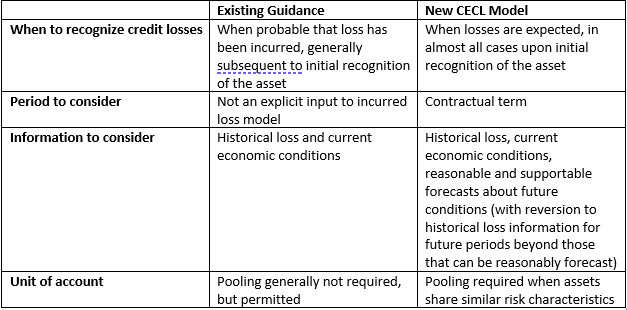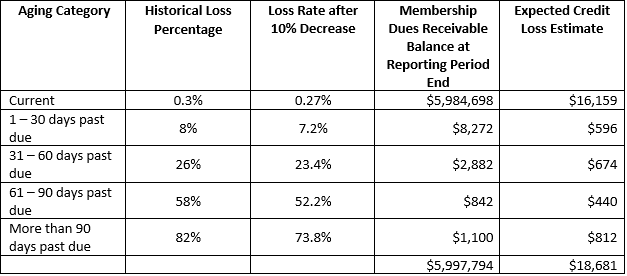Nonprofits have endured the challenges of adopting several new accounting standards over the last several years. Now, after a lengthy deferral period, the Financial Accounting Standards Board (FASB) Accounting Standards Update (ASU) 2016-13, Financial Instruments – Credit Losses (Topic 326): Measurement of Credit Losses on Financial Instruments), commonly referred to as CECL or “Current Expected Credit Losses,” is upon us. Subsequent ASUs were issued related to CECL, which are all codified in the Accounting Standards Codification (ASC) Topic 326.
A Brief Background on CECL
What Items Are Impacted by CECL?
The extent of CECL applicability depends upon the financial assets held by each organization. Generally, financial assets measured at amortized cost, like trade receivables, cash equivalents, contract assets that result from revenue transactions or other income, loan/notes receivable, loans to officers and employees, financing receivables and program-related investments, are required to be assessed under the CECL model. Financial assets that are measured at fair value, equity method investments, and related party loans and receivables between entities under common control, are not. Contributions and pledge receivables (receivables associated with revenue recorded under FASB ASC Topic 958-605) are not in the scope of CECL.
What Is Changing With CECL?
Prior to CECL, organizations utilized an incurred loss model. The incurred loss model is largely based on historical losses whereby a loss is recognized only after a loss event has occurred or is probable. In other words, an allowance for doubtful accounts was recorded based primarily on past experience. Under CECL, however, entities will estimate credit losses over the entire “contractual term” of the instrument from the date of initial recognition of that instrument through the end of its term. Now, instead of an allowance for doubtful accounts, organizations will have an allowance for credit losses.
CECL’s objective is to provide financial statement users with an estimate of the amount the entity expects to collect on these assets. The CECL model removes the threshold of “probable” and requires recognition of credit losses when such losses are “expected.” That is, even though a credit loss event may not have occurred yet, lifetime losses would still be recorded on Day One (i.e., origination or purchase of the asset) under CECL based on the expected future losses.
The following chart provides a summary of the changes from the incurred loss model to the expected loss model.

What Are the Elements of CECL?
In order to implement CECL appropriately, organizations must follow the model outlined by CECL, which allows for management judgment throughout each step. The importance of management’s documentation of those judgments and estimates is key to the implementation and continued compliance with this standard. The graphic below provides an outline of each of the elements of CECL.
Components of CECL Model
Historical Loss Information
Segments or pools are created based on common characteristics. A combination of both internal and external information, including macroeconomic variables, are used to establish a relationship between historical losses and other variables.
Current Conditions
To reflect current asset-specific risk characteristics, adjustments to the historical data will need to be considered. These adjustments are usually done through a combination of both qualitative and quantitative factors.
Reasonable & Supportable Forecasts
The forecast period to project expected credit losses should be reasonable and supportable. Document the rationale and provide evidence supporting the reliability and accuracy of economic scenarios and forecasts.
Revision to History
Entities are to revert to historical loss information when unable to make reasonable and supportable forecasts. The reversion method applied must be well documented and is not a policy election.
Expected Credit Loss
The results should represent the current expected credit loss over the remaining contractual term of the financial asset or group of financial assets.
Let’s discuss each of the components of the CECL calculation.
Historical Loss Information
Generally, historical credit loss experience of financial assets with similar risk characteristics provides a basis for an organization’s assessment of credit losses according to ASC 326-20-30-8. While organizations are accustomed to gathering historic loss information, ASC 326-20 introduces the concept of portfolio segmentation or pooling, which is likely new for most nonprofit organizations. CECL requires management to measure expected credit losses on a collective (pool) basis when similar risk characteristics exist. When similar risk characteristics do not exist, CECL requires management to measure each financial asset with different risk characteristics individually. Management should document the rationale for the selection of each pool. Management is also required to revisit the pools when information arises that suggests a particular financial asset or assets may no longer exhibit similar risk characteristics. ASC 326-20-55-5 provides a list of potential risk characteristics an organization may consider when identifying pools. The list is not meant to be all inclusive, and management may identify other risk characteristics to develop pools of financial assets. Management should document the rationale for the selection of each pool.
- Internal or external (third-party) credit score or credit ratings
- Risk ratings or classification
- Loan purpose
- Collateral type
- Size
- Effective interest rate
- Term
- Geographical location
- Industry of the borrower
- Vintage
- Historical or expected credit loss patterns
- Reasonable and supportable forecast periods
To illustrate the concept of pooling and the CECL model, let’s walk through an example of what this analysis might look like for a nonprofit organization with membership dues that are recorded as revenue under ASC Topic 606. We will continue with this example as we discuss each of the elements of the CECL model.
Facts of the Example:
ABC NFP provides services to their members. The members are homogeneous and have the same risk characteristics. Members are given payment terms of 90 days. ABC NFP has tracked historical loss information for its membership dues receivable and compiled the following historical credit loss percentages:

In the example above, because the members have similar risk characteristics that management considers homogenous, a single pool of all members was used by ABC NFP to analyze the accounts receivable balance associated with membership dues. There could be instances where organizations may pool members based on type of member (i.e., large corporate members versus individual members) or by geographic location of members (i.e., international members versus members based in the United States), just to name a couple of examples. The method is based on management’s judgment and the rationale for the pooling method should be documented.
The example above outlines historical loss percentages in an aging model that the organization is using as the basis for its CECL analysis. The historical loss percentage is another estimate within the model that management must determine and document. Management might choose to use a specific historic period to calculate the percentages. For example, assuming the makeup of members has not changed since the inception of the organization, management may choose to use historical loss information from the inception of the membership program. Or perhaps management may choose to use an average of the prior five or 10 years, excluding the years impacted by the COVID-19 pandemic due to the effect on its members. The important point is that the standard does not prescribe a “right” or “wrong” method. Instead, management must make these determinations and document the rationale for the method chosen.
Current Conditions
Once the historical loss information is determined, management must evaluate if any adjustments are needed to make the information current. The standard indicates that an organization should not solely rely on past events to estimate expected credit losses. The standard goes on to describe that, when an organization uses historical loss information, it shall consider the need to adjust historical information to reflect the extent to which management expects current conditions and reasonable forecasts to differ from the conditions that existed for the period over which historical information was evaluated. For example, are payment terms for the current period different than the historical period used in the analysis? In our ABC NFP example for membership dues, the organization would need to consider the current make-up of the types of members and their “creditworthiness” compared to the creditworthiness of the types of members included in the historical analysis. Another factor ABC NFP may consider is the payment terms. Perhaps historical payment terms were 90 days, and in the current year, ABC NFP changed the payment terms to 120 days. In this case, ABC NFP would need to determine how the impact of the change in payment terms affects their historical analysis. Perhaps ABC NFP would need to add another aging category to the historical analysis determination to capture the change in payment terms.
Reasonable and Supportable Forecasts
The next phase in the CECL model is for organizations to determine the reasonable and supportable forecast period and the related forecasts made in order to estimate credit losses. This is not an optional element of the standard – an organization must develop estimates for reasonable and supportable forecasts and document the rationale for the forecasts made as well as the period(s) being forecasted. These judgments are inherently subjective and complex and may result in a high degree of estimation uncertainty. The adjustments to historical loss information may be qualitative in nature and should reflect changes related to relevant data (such as changes in unemployment rates, property values, commodity values, delinquency or other factors that are associated with credit losses on the financial asset or in the group of financial assets). This is yet another reason it is imperative for organizations to document their rationale for all of the judgments and estimates being used to develop the expected credit losses.
Let us continue with our example for ABC NFP and introduce a few more facts:
- ABC NFP believes that the historical loss information is a reasonable basis to determine expected credit losses for membership dues receivables held at the reporting date because the risk characteristics of its current members and its current credit practices have not changed significantly over time.
Why is this fact pattern important for the CECL model?
This particular fact pattern is demonstrating that there are no adjustments necessary for the “current conditions” element of the CECL model. Current practices, for purposes of this example, are not different than historical practices; therefore, management documented in their CECL analysis that no adjustments for current conditions are necessary.
- However, ABC NFP has determined that the reasonable and supportable forecasted economic conditions have improved. The unemployment rate has decreased as of the most recent reporting period, and ABC NFP expects the unemployment rate to continue to decrease over the next 90 days.
Why is this fact pattern important for the CECL model?
Management is required to consider reasonable and supportable forecasts. In this particular example, management has chosen to use the unemployment rate as their means to forecast over the contractual period. For purposes of this example, let’s assume the members are individuals and the contractual period is 90-days, which is equivalent to the payment terms. The use of unemployment data as a way to forecast expected credit losses is a reasonable and supportable forecast because members are individuals. As the unemployment rate declines, more individuals are employed and would, in theory, be able to pay for their membership dues. In management’s view, there is enough economic data available to allow them to expect the unemployment rate will continue to decline. An organization needs to document these conclusions and sources of economic data as part of their CECL analysis.
- ABC NFP estimates the effect of the decrease in the unemployment rate will impact the loss rate by a 10% decrease in each aging bucket. Management’s estimate was developed based on its knowledge of past experience for which there were similar improvements in the economy.
Why is this fact pattern important for the CECL model?
The reasonable and supportable forecasts element of the model requires an organization to quantify the forecasts to include in the calculation of expected credit losses. In the example, ABC NFP determined that the loss rate would decrease by 10%. ABC NFP may have calculated the 10% by looking back to prior years when the unemployment rate was low and comparing the overall uncollectible accounts to a set of years when unemployment was high. On a percentage basis, that calculation yielded an approximate 10% difference in uncollectible accounts. The rationale for this method and the calculations that support the 10% loss rate decrease need to be documented as part of the CECL analysis.
Reversion to History
An organization should revert to historical loss information that is reflective of the contractual term of the financial asset or group of financial assets, adjusted for prepayments, for periods beyond which the organization can make reasonable and supportable forecasts of economic conditions. Reversion to history does not mean an organization can skip the current conditions and reasonable and supportable forecast elements of the CECL model and immediately revert to history. The key takeaway when considering reversion to history is the period beyond which reasonable and supportable forecasts can be obtained or determined. Generally, we believe organizations should be able to forecast at least one year from the contractual starting period of the financial asset, if not more. This is, again, a judgment management must make and document as part of its CECL analysis. In following with our ongoing example of ABC NFP and its membership dues receivables, the contractual term of the membership dues is 90 days. Management has determined it can reasonably forecast a 90-day period, so no reversion to history was necessary in this example.
In contrast, let’s consider a different example for an organization that has a 15-year note receivable. That organization may determine it can reasonably forecast three years; so, for the remaining 12 years, the organization will utilize a reversion to historical loss information to estimate the expected credit losses.
Entities are to revert to historical loss information when they are unable to make reasonable and supportable forecasts over the contractual term, adjusted for prepayments. The reversion technique applied must be well documented and may not be a policy election. Therefore, the organization must separately evaluate each pool of assets when determining which reversion technique is most appropriate.
Examples of reversion techniques that might be used are immediate reversion and straight-line reversion. Immediate reversion is accomplished by reverting to the full historical loss rate at the point that forecasts are no longer reasonable and supportable, whereas straight-line reversion is accomplished by adjusting the reasonable and supportable forecasted loss rate in increments to revert back to the historical loss rate and will require judgment as to the length of time over which the straight-line period should be. Other reversion techniques may be used as long as they are rationale and systematic.
Expected Credit Loss
The final element of the CECL model is calculation of the expected credit loss. The standard does not prescribe a specific methodology for measuring the allowance for expected credit losses. For example, an organization may use discounted cash flow methods, loss-rate methods, roll-rate methods, probability-of-default methods or methods that utilize an aging schedule, just to name a few. Organizations need to document the rationale for the selection of the calculation method as well as the calculations themselves.
To complete our example for ABC NFP, the following is a chart to show how the organization arrived at the expected credit loss recorded as of the end of the reporting period.

ABC NFP utilized an aging schedule method by applying the loss rate after the 10% decrease to the member dues receivable balance at the end of the reporting period.
Zero Loss
Now that we have made our way through the basics of the CECL model, there’s another principle of the standard that’s worth mentioning. It is not uncommon for an organization to deem receivables or other financial assets to be fully realizable. Based on this, organizations may want to simply not record any expected credit losses for certain financial assets. Unfortunately, the CECL model does not allow us to jump directly to the conclusion of zero loss without walking through the model. An organization’s estimate of expected credit losses shall include a measure of the expected risk of credit loss even if that risk is remote, regardless of the method applied to estimate credit losses. An organization is not required to measure expected credit losses on a financial asset (or group of financial assets) in which historical credit loss information adjusted for current conditions and reasonable and supportable forecasts results in an expectation that nonpayment of the amortized cost basis is zero.
In other words, a remote risk of loss does not mean there is zero loss, so we would expect there to be some estimated expected credit loss, albeit potentially a minimal amount. If an organization performs the assessment based on the CECL requirements, and, after documenting the history, current conditions, and reasonable and supportable forecasts, determines the estimated loss is zero, the organization has sufficiently proven no estimated expected credit loss is required.
Adoption Date and Adoption Options
CECL is effective for nonprofit entities for fiscal years beginning after Dec. 15, 2022. Thus, the standard is effective beginning with Dec. 31, 2023 year-ends.
The standard requires organizations to adopt on a modified retrospective basis through a cumulative-effect adjustment to net assets as of the beginning of the first reporting period in which the guidance is effective. So, in the year of adoption of CECL, organizations will need to complete their credit loss analysis twice – once as of the date of adoption and once at the end of the fiscal year. For example, an organization that has a Dec. 31 fiscal year-end will need to perform its CECL analysis as of Jan. 1, 2023, and again as of Dec. 31, 2023. On Jan. 1, 2023, the organization will increase or decrease net assets without donor restrictions for the adjustment made to either increase or decrease the allowance for doubtful accounts. The historical allowance for doubtful accounts is renamed allowance for expected credit losses. In years subsequent to adoption, organizations will be required to reassess their CECL analysis as of the end of their reporting period.
Will My Footnote Disclosures Be Impacted by CECL?
Yes. There are significant new CECL-related disclosure requirements that could be rather voluminous depending upon the composition of an organization’s financial assets measured at amortized cost that are impacted by CECL. Organizations will need to disclose a description of the method used to develop expected credit losses, a description of the accounting policies and methodology to estimate the allowance for credit losses, a discussion of the relevant risk characteristics for each segment of the portfolio, among other items. In order to ensure the organization has met all of the disclosure requirements, ask your auditors for a copy of the disclosure checklist or utilize the ASU to assist you early on in the financial statement preparation process.
A Documentation Exercise
For organizations with significant financial assets measured at amortized cost, the implementation of CECL, along with the ongoing requirements of the standard will take time. While your financial statements may not have a material change in the amount previously recorded as the allowance for doubtful accounts, and now recorded under the expected credit loss model, the documentation associated with the estimates and judgments to arrive at the expected credit loss balance is necessary to demonstrate compliance with this new standard.
BDO has published a practice aid, titled “CECL for Non-Financial Institutions,” that can be accessed on www.bdo.com at this link.
Written by Amy Duffin. Copyright © 2023 BDO USA, P.C. All rights reserved. www.bdo.com




